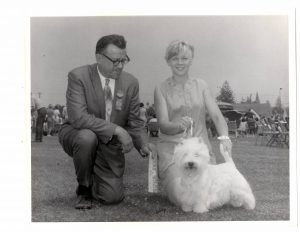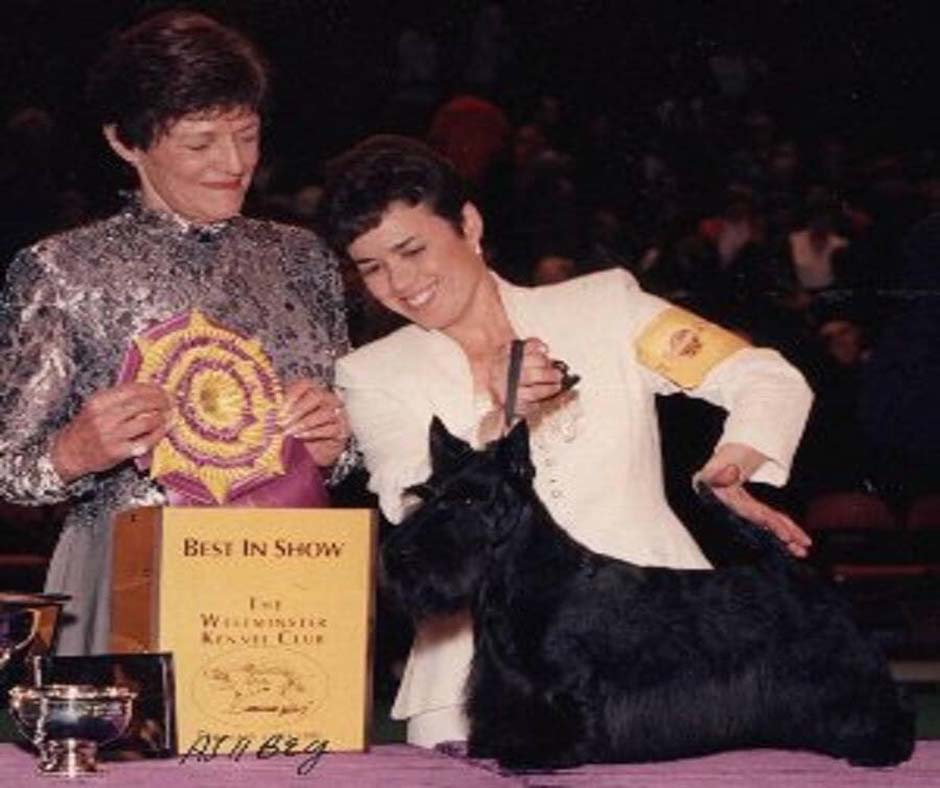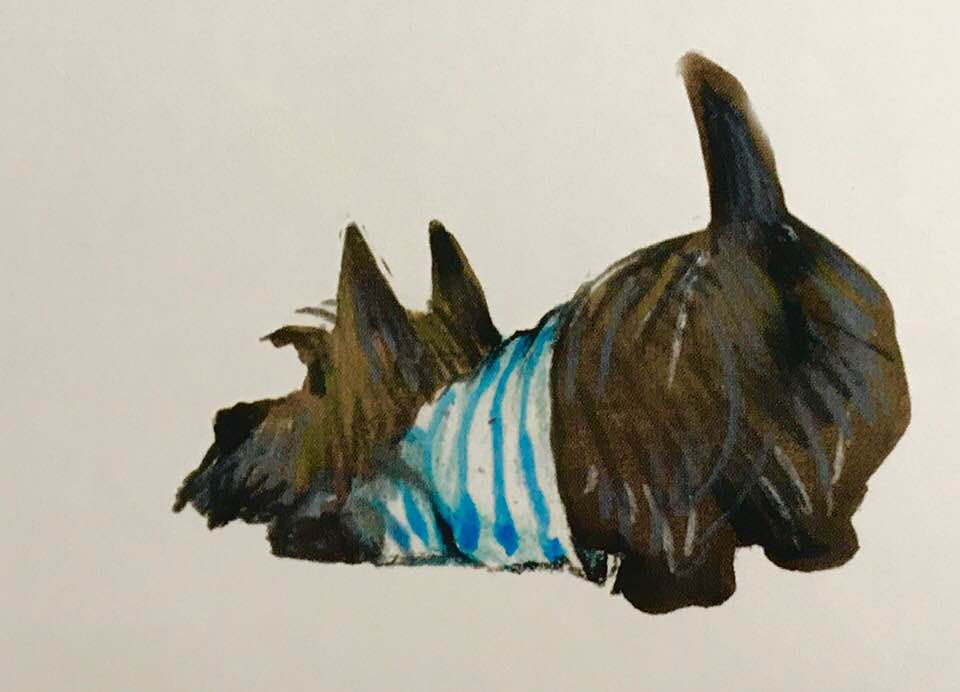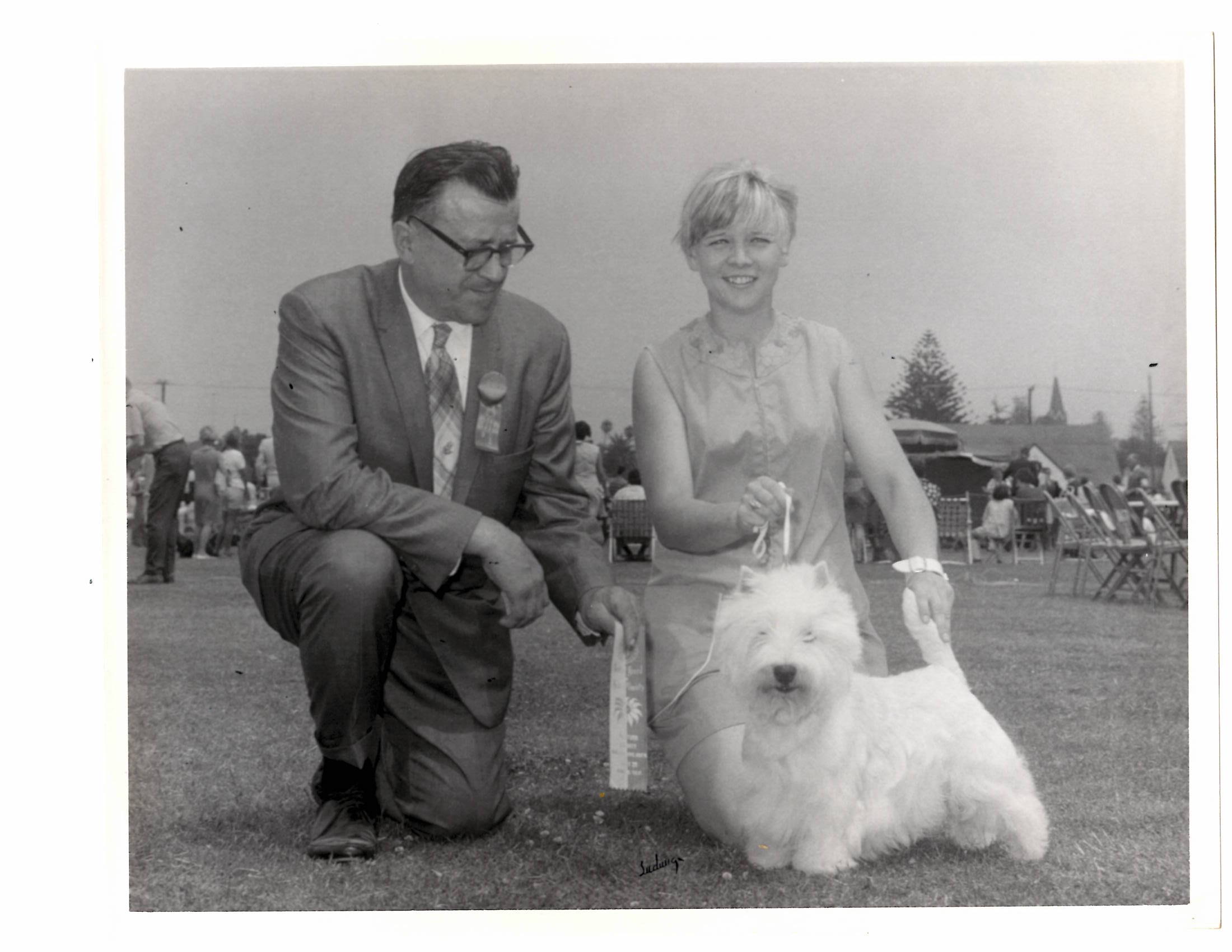673 – Maripi Wooldridge on How to Make Your Dog a Winner
Maripi Wooldridge on How to Make Your Dog a Winner
Host Laura Reeves is joined by Maripi Wooldridge, handler of the 1995 Westminster Kennel Club Best in Show winning Scottish Terrier, Ch. Gaelforce Postscript. More recently, Maripi’s Lakeland Terrier MM won the group here in 2022. Maripi takes us through how she thinks about making a dog a winner.

Maripi Wooldridge judging the 2024 Wire Fox Terrier National Specialty show.
LR: If you want your dog to always be best in show ready? Any breed, what are your three top tips?
MW: Conditioning both mental and physical. They have to be fed right, exercised right. Mentally, they have to be treated like they’re best in show dogs so they know it. I think you always have to start out with a good dog and people think that ‘oh good enough is good enough’ and good enough is just not good enough.
A lot of people do some winning with “good enough” but to really have a top dog you have to have good ones and you have to manage them right. You have to manage how you go to dog shows, where you go to dog shows, and have a good relationship with your clients. Nowadays, there are way fewer good clients and money clients that can afford to do this business.
LR: Treat it like a best in show dog. What does that mean to you? What does that look like to you?
MW: Well, as far as my breeding program, I bring every puppy up like if it’s going to be a good one. I think most good breeders and successful breeders do that. Anybody that can pick a puppy at eight weeks and put their mortgage on it, they’re way better than me.
But when you get them in as a handler, they have to feel special. They have to feel special over the class dogs that are gonna go home in a month and a half. They have to have things whether it’s walks, whether it’s put on the table every day, and even if you just brush their coats or clean their coats or pet ’em, so that they know they are special. Bring them in last instead of first, so that they are the big dogs around. I mean, little things that mean a lot to the dogs that people don’t even think about. First out in the morning, that’s very big if you want a dog to feel special.
It makes a huge difference, especially with the smart breeds. I mean, there’s some dogs that doesn’t really matter, they’re fine, I’m here. But with breeds that are clever and smart, you have to bend over backwards.
I had an assistant when I was showing Peggy Sue that would go in the crate room in the middle of the night with a flashlight to look into her crate to see how she was laying because she would wake up in the morning and have like a little wrinkle on the side of her coat. So she made bedding so that she would not get that little wrinkle on the side of her thigh. That level of attention is absolutely needed for a dog to give you everything they have.
The second half of the episode is available for Patrons Only. Subscribe at https://puredogtalk.com/patron/to hear more from Maripi’s decades of insight.
269 – Authors: Clean Paws Are Very Important For a Scottie, You Know
Clean Paws Are Very Important For a Scottie, You Know

DWAA Award Winners Rod Ott, Pilar Kuhn, Larry Linder and Lisa Peterson at the awards banquet.
Pilar Kuhn and Rod Ott, authors of the award-winning children’s book “Clean Paws are Very Important for a Scottie, You Know” joined host Laura Reeves live at Westminster Kennel Club.
Scottie registrations are down, Kuhn said. The breed has witnessed an astonishing 70 percent decrease in overall number of registrations in the last 15 to 20 years.
Ott believes the “Adopt don’t shop” mentality has impacted registrations. He also notes that breeders have aged out and the overwhelming number of activities available makes it harder to get young people involved.
Kuhn and Ott share with Laura the five-year long story of developing the book idea, acquiring the illustrations, battling cancer, and the life-saving focus the project provided.
The hardback book brings children’s attention to purebred dogs, teaches life lessons and features charming illustrations of Scottish Terriers.
“With every purchase of our book, we will be donating a portion of the profits to help fund research for childhood cancer and to the Scottish Terrier Club of America Health Trust Fund,” Kuhn said. “Why? Our lives were changed several years ago when we sold a Bouvier in 2014 to a young girl Noah Nechemia who was going through recovery from medulloblastoma. She is now 4 years a Survivor. Childhood cancer receives less than 4 percent of all funding toward research and we are not OK with this. We are donating a portion of the profits from the sales of our books to the Cancer Prevention and Research Institute of Texas that did so much for Layla Stamp and her family and because of our dedication to preserving the Scottish Terrier, we want to help support research on health problems affecting Scottish Terriers.”
Bravo Scotties Chicory and Dee Dee will be going through the Pet Partners International Therapy Dog program to become certified Therapy Dogs and will later accompany the authors not only to hospitals to visit children, but also to elementary schools around the country. In the schools, Kuhn will read the book to children and help educate them on the Scottish Terrier and give kids a chance to meet a real, live Scottie.
178 — Bergit Coady Kabel: “Groomed to Perfection”
A Legend in the Terrier Ring

Bergit Coady Kabel with a West Highland White Terrier in years gone by.
The 2012 Winkie Award for Best Professional Handler, said it best: “A legend in the Terrier ring, Bergit Coady Kabel’s dogs are always groomed to perfection and flawlessly presented. Always polite and professional, she is totally dedicated to her dogs.”
Hard Work and Dedication
Bergit was someone I admired from afar for my entire handling career. I didn’t get to see her often, as our paths rarely crossed in the particular shows we attended. Every time I saw her, I was impressed by her immaculate charges and her unfailing smile.
I talk with a lot of folks for the podcast who have achieved the highest levels of success in purebred dogs. And I consistently hear the same themes. Hard work. Dedication. And an unquenchable thirst for knowledge. Bergit is a leading voice in the chorus.
Responsibility Gave Joy
Bergit tells the story in today’s podcast about being 13 years old and excited beyond words to have been taught by her earliest mentor how “to clean teeth, bathe dogs, express anal glands, and clean ears. … and the happiest kid you could have found.”
Let that sink in for a minute. Here is a kid who was *thrilled* to do anal glands because “Finally I knew a few things to do with dogs.”
Many successful handlers apprenticed for Bergit over the years. “A few assistants that wanted to do this by the clock, needless to say, did not work out,” she noted.
After a recent illness, Bergit is recovered and ready to take on judging with that same focus and intensity.
Focusing on Judging
“After 50 successful years of handling, I feel I can try to give back a little to a sport that has given me so much,” Bergit said. “I know judging will present different challenges and I will educate myself every step of the way. Will I like it better than handling? Never. I loved every minute of my handling career.
“…my son Ryan said to me. He is fully aware of my love for handling. He said, ‘You know, you are very lucky that you can go into judging. There’s a whole big world and big dog family. So you can see your friends again.’ He does mortgages and he said, ‘When I’m done there is no mortgage family waiting for me.’”
Bergit’s concrete advice on reaching the pinnacle of perfection in trimming dogs is invaluable. And we start a new feature on the show “All Time Favorites Best in Show Lineup.” Listen now to hear which dogs she would have in that ring and who would win!
Laura: Welcome to pure dog talk, I’m your host, Laura Reeves, and I am joined by a member of our sport who I have long had mad respect for and I think she just brings such incredible knowledge to the game of purebred dogs. So I would like to welcome Bergit Coady Kabel to our conversation because I think you guys are going to really, really enjoy this one. So thank you. Bergit. How are you today?
Bergit: Really good, thank you. Very good. Excellent.
Laura: So we have a thing here on pure dog talk that we ask our guests to give us the 411, right? The who, what, when, where, why, how, how did you get started? How did you get involved in dogs? You’ve been at this for a lifetime now, right?
Bergit: Yes, definitely. Yes. I will have to tell you how it all started. When I was five years old, my family moved from southern Germany to downtown Hamburg. Soon after that, my earliest recollection is this, and a bit old neighbor girl was able to walk a wire Fox terrier for friends. One day she let me hold the leash. I was so thrilled and could not wait to tell my mom. You would have thought I won a box of toys. I have always been crazy about dogs. Maybe got the gene from my grandmother. She loved animals. A few blocks away from where we lived in Hamburg was a grooming shop owned and operated by Mr and Mrs Buchhaltz, who were excellent dog people and also show people. They owned a Mini and a Toy Poodle, an Irish Terrier and a Scottish Terrier. For a long time I was forever trying to figure out how I could get to know them. Remember I was only a young kid then, and the dog world was not like it is today. My break came when the Buchhaltz’s daughter, who was in the same class as my younger brother, came into the classroom and asked for her parents. They were looking for a babysitter for the two year old sister. Bingo. I was it.
Bergit: I babysat… and every minute, after my job was done, I was spending time with the dogs. I was a dog walker at first and I kept telling the Buchhaltz to please teach me grooming. I was fascinated by what all the employees could create. So after awhile Mr Buchhaltz decided he had to do something with me since I was always around. The first things he taught me was — this is no kidding — to clean teeth. bathe dogs, express anal glands and clean ears.
Laura: And you were how old Bergit?
Bergit: I was 13 at the time. And the happiest kid you could have found. Finally I knew a few things to do with dogs. At that point they also started to take me to some dog shows, you know, later on in life, much later on in life. I kept thinking back to this and I was thinking maybe Mr Buchhaltz thought, you know, if I let her do all of these things…we’ll get rid of her! But it didn’t happen. By the time I left school, I agreed to a three year apprenticeship with the Buchhaltz. My parents were devastated. My mother’s dream was for me to be a super secretary like she was, but sitting still has never been easy for me. So at this point, the Buchhaltz did not really need a fourth girl.. the three they had were excellent. So they asked if I would like to go to England to work in a well known Scottish Terrier Kennel “Riander” for Mrs Elizabeth Meyer. They took me with them to Crufts and we were introduced and I looked at all the Scotties like many people would do and said, how do you know which one is which one? So this was the basic beginning to my fabulous life into dogs. I spent two years in the UK and then one year at the Buchhaltz grooming shop. They agreed to the second year if I agreed to no time or days off for that. year. That was fine. I didn’t care.
Bergit: So basically my most important mentors besides the Buchhaltz was Mrs Meyer of Riander fame. To this day, I refer to something I was taught by her daily and we don’t even own our kennel anymore. There are two most important elements that I live by. Mrs Meyer said, number one, you have to be able to take care of yourself first before you can take care of someone else or something else. Second, when taking care of dogs, you yourself have to know what goes into a dog and what comes out of a dog, so you have to look at each one every day. From her I learned how to put down a Scottish terrier, and once a month she insisted to drive me to a well known Westie breeder who taught me how to trim Westies I would spend all day at her place. Now comes the question of how did you come to the United States? Well, spending two years at the Riander Kennel in England, I met many American Scottish Terrier breeders that came to visit the Kennel. One day, Betty Malinka of Sandoone Scottish Terriers, visited and asked if I would like to come for one year to work for her in Gary, Indiana. I agreed. End of history. This year, March 12, was my 50th anniversary of arriving at Chicago O’hare.
Laura: That is pretty amazing. Bergit. I’m sorry. That kind of made me a little choked up for a minute.
Bergit: Yeah. Yeah. That’s amazing. Working for Betty was fun. She took me to a lot of shows and also I met a lot of people and that’s how I met Clay Cody.
Laura: Yes.
Bergit: We started with our limited experience but taught ourselves a lot by watching top handlers at the time. Yes, we were fortunate to have some great dog people apprentice under us… and we are still very proud of them. Again, trimming you can teach, conditioning as well, but you have to have a certain feeling for dogs. If you had assistants that wanted to do this by the clock, needless to say, that did not work out.
Laura: No,
Bergit: We always started from scratch. If a dog needed a new coat, it was stripped down… in 10 to 12 weeks later you started to show it. It takes that long on any strip breed to get the coat into show length.
Laura: Yeah.
Bergit: In the meantime, you will take care of furnishings and everything else on the dog, exercise and fresh air are of great importance… and having had a super kennel with 58 runs in southern California for 40 years was more than ideal. We also had a set of runs where you could get a profile view of the dog from the dog kitchen, and that was enlightening and very useful. All of the above we brought to the attention of all of our assistants. Your question about habits to condition and groom a dog, is difficult to answer. A dog has to feel you like him. That’s the start of everything. Then you start by putting him on the table every day, often just for a little while because once a dog is stripped, you have four to six weeks before you do what we call a defuzz, which is the same as a cleanup, but furnishings need to be washed every two to three days and blow dried.
Bergit: The dog gets used to your hands and where you put them. Be consistent in making the same movements. Always be peaceful. Don’t do any of this if you need to rush. By the time you need to put a final show trim on the dog, he should be able to stand on the table perfectly relaxed and display confidence. Anyone with love for dogs can do this — Owner-Handlers or Handlers. The secret ingredient, as you call it, to a perfectly trimmed dog, is looking at it as many times as it takes on the ground, after you finished trimming it in front of a mirror, of course on the table. Then on the ground, someone has to walk the dog for you so that you can see him in profile as well as up and down. Whatever you need to correct… then you correct it, but you can never take a dog off the table even though it looks perfect and think that that’s how it’s going to look. Because once the dog shakes or moves differently, you can have a completely different picture.
Bergit: So this is of course more work and a lot of people’s excuse is they don’t have somebody that can walk the dog, BUT you can always, if you get to the dog show early, find somebody that would do it for you, and even if they don’t walk it correctly or perfectly like you would, you can still see certain things. The other thing that a lot of people don’t do is to take a dog for a regular walk. I don’t mean at a dog show. I mean just down the street to look and hear and see strange things. Always talk to your dog and pet him in between. You will bond nicely. You have to have good work ethics, a lot of self discipline and most of all a passion for this whole dog show scene in order to make it work.
Laura: I would agree with that.
Bergit: After all. Then you asked me about judging.
Laura: YES. This is a new journey that you’re taking on, right? Just getting started, yes?
Bergit: Right, after 50 successful years of handling, I feel I can try to give back a little to a sport that has given me so much. I know judging will present different challenges and I will educate myself every step of the way. Will I like it better than handling? Never. I loved every minute of my handling career. To end this interview, I would love to tell you what my son Ryan said to me. He is fully aware of my love for handling. He said, you know, you are very lucky that you can go into judging. There is a whole big world and big dog family. Most of all, you know each other. So you can see your friends again. He does mortgages and he said when I’m done, there is no mortgage family waiting for me.
Laura: I love that. It’s totally the truth, Bergit.
Bergit: It’s totally the truth.
Laura: You know, I just got done interviewing Lorraine Boutwell for example, and she talks a lot about this and a lot of the people I talk to about this, they started in dogs either as breeders or as breeders and then handlers or what have you… and continued judging and I think so much of it is because this is your family. Right?
Bergit: Right. Right. And I mean, you have no idea. I mean when I got sick, I mean I still have all the cards and all the stuff and I mean it was incredible. You know, I was just truly overjoyed and now everybody that sees me at a dog you know, goes crazy and is happy for me
Laura: like I did.
Bergit: You know, I’ve always tried to help everybody. Because people tend to dislike you when you win a lot, but you know, that’s never affected me. You know, I’ve always given credit to where credit is due and you know, I think people remember that. You know.
Bergit: I think so too. So two more things. Your best advice… especially for the people that are getting started. We have lots of people who listen to this podcast who are less than five years, for example, with purebred dogs. What is your best advice for these folks when they’re getting started? Showing their dog, grooming their dog, whatever it is.
Bergit: Definitely to get the best rapport going with your dog. That means you take the dog for a walk just as a pet. You pet it, you talk to it. You make sure it learns to stand on the table perfectly still so that you can groom it. Whatever dog it is… in order to groom it you can’t be fighting with it. That you can’t be every time making excuses, for it or all these things. But if a dog knows that you want this from him, you give him so much. To my mind, the dog can also give something back to you and they’ll figure it out. I mean it doesn’t matter what we dealt with many different bleed, you know, so you have to be patient and then when you need help you try and get helpful my hand low or if you watch somebody at a dog show that you think could give you ideas, you approach that person at the end of the day or when there’s a break, obviously not while they’re showing a dog, you know, most people will help you and that’s how you really keep going. And if you run into somebody that won’t help you, don’t be discouraged and go to the next person that you think could do it for you.
Laura: Yeah, and I think that that’s so true. And one of the things that has kept me going, I mean every time I handle a new breed… I go ask someone. That’s just a thing I do and I think that if you just are willing to ask, people are always willing to help, somebody will help you.
Bergit: Yeah. I mean look at it. A few years ago somebody offered us a Komondor. I had finished two Wheatens for them in 1987. They said to me, do you want to show a Komondor? And I said yes. I said, I don’t know much about them, most people don’t, but I said Bill McFadden knows and I’ve seen him show one. And I said I will talk to him and I will get all the information and I will do everything he tells me. So I got it finished. And of course you have to be friends with people in this breed because there’s so few of them that you have to know when there will be a major, you know. And we got it done. But it was really interesting, you know, I mean it was great to do it differently like that.
Laura: I did a Briard, I mean completely outside my comfort zone. And it was great fun, I really enjoyed it because you get that chance, right, to learn something new.
Bergit: Yeah. Yeah. And the same with the Black Russian. I got a Black Russian finished… also with the help. This is when the kind of first started, you know, also with the help of key people and you know, I’ve never forgotten the people that have helped me, you know, and they get a Christmas card every year. I mean I’m a great Christmas card writer. I’m sorry. I like to do that. You have to do these things, you know.
Laura: Yes, absolutely. Okay, so then listeners, you guys are gonna love this. We’re going to add this as a new feature for all of the interviews that we do with some of our great legends of the sport and Bergit gets to be our test case. So Bergit? Now you have 50 years in the sport in the United States. So I’m asking you in your mind, and this is a game we play as handlers, right? Like, I’ve always done this. So, in your mind, the greatest best in show lineup of all time… of dogs that you have personally seen. Ready, Go!
Bergit: I would say for the Hound Group – Pepsi, the Afghan Hound. For the herding group… Manhattan, the German shepherd. Non-Sporting would definitely be London, Standard Poodle, black Standard Poodle. Terrier… Coco the Norfolk.
Laura: Wow. That says a lot coming from you. Wow!
Bergit: Yup. Yup. Working… and that would probably win my best in show right there, Matisse, the Portuguese water dog.
Laura: Okay…Wow.
Bergit: Toy…John Oultan’s Papillon, Kirby,
Laura: Beautiful.
Bergit: Sporting… the Black Cocker of Michael Pitts — Beckham.
Laura: Those are some beautiful, beautiful choices and I think since I saw this in somebody else’s social media and I said, it tells so much about what you value as a judge, as a handler or what have you, what you see in that best in show lineup. I just think it is a wonderful, wonderful thing. Plus it makes us think about cool little dogs. Awesome. Alright, well Bergit, thank you so much for your time. It was wonderful to see you at the dog show a few weeks ago. I am thrilled to see you back and I wish you the very, very best in your judging career. You will be outstanding.
Bergit: Thank you so much. I appreciate that. Thank you. Take care. Okay..bye-bye.



